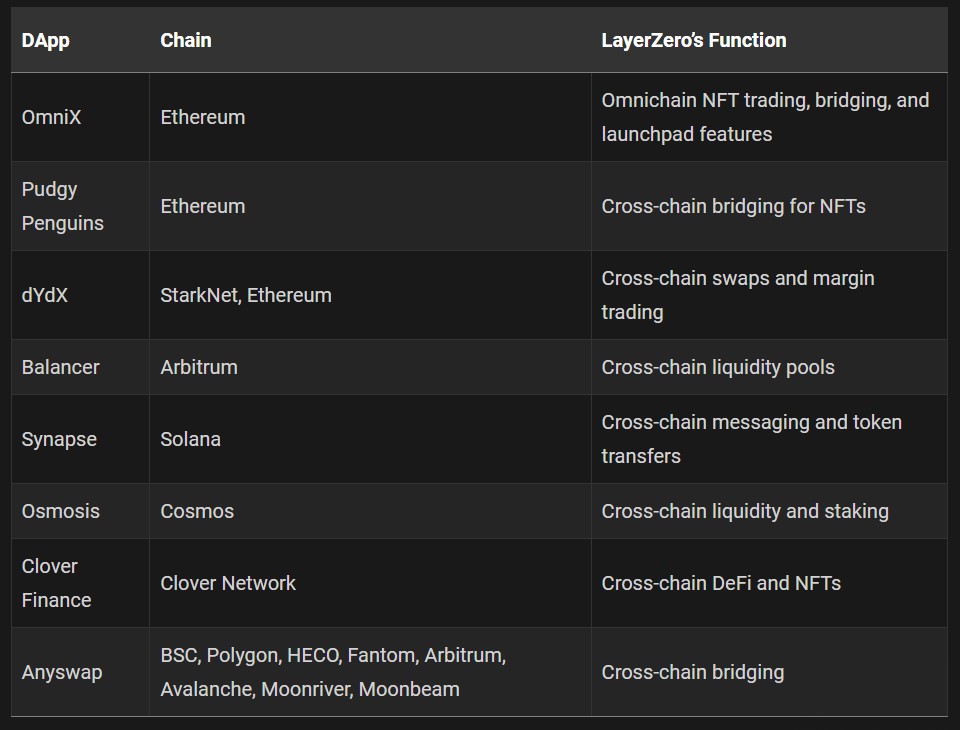Throughout the course of its decentralized odyssey, the trajectory of blockchain and distributed ledger technology has been plagued incessantly by a formidable nemesis: interoperability conundrums. Achieving seamless blockchain interoperability necessitates the implementation of standardized data formats, consensus mechanisms, secure communication channels, and secure, scalable interoperability protocols.
Enter LayerZero, the beacon of hope amidst this interchain labyrinth. But what exactly is LayerZero and how does it vanquish the blockchain interoperability problem?
Delving Into the Depths: Unraveling the Essence of LayerZero
LayerZero, a cross-chain communication protocol, emerges as the valiant savior that facilitates direct and trustless communication between blockchains. Irrespective of architectural disparities, LayerZero forges the path to interoperability, embracing a multitude of blockchains including SUI, Aptos, EVM Chains, and Solana. Through the power of LayerZero, projects can now establish interchain operability with unparalleled ease.
Revolutionizing Blockchain Interaction: LayerZero’s Profound Impact
The inception of LayerZero has instigated a paradigm shift in blockchain interaction, rendering the need for centralized intermediaries such as bridges and decentralized exchanges obsolete. Through direct communication channels, LayerZero breathes life into a decentralized and secure blockchain ecosystem, opening a realm of unprecedented possibilities for cross-chain applications.
The Inner Workings: Unraveling the Enigmatic Mechanism of LayerZero
At the heart of LayerZero lies a unique approach known as “Ultra Light Nodes” (ULNs) that enable interchain communication. These lightweight blockchain clients possess the remarkable ability to validate transactions on other chains sans the need to download the entirety of the blockchain state.
Harnessing the potential of ULNs, LayerZero achieves remarkable throughput and minimal latency during interchain communication, effortlessly traversing different architectures and consensus mechanisms.
Deployed within each participating chain, ULNs maintain a partial view of the chain’s state while utilizing this knowledge to validate transactions originating from other chains.
Relayers, acting as off-chain service providers, bear the responsibility of transmitting messages between ULNs on different chains. Incentivized by rewards, these diligent relayers prioritize the prompt and reliable relay of messages.
A third-party service, the Oracle, serves as a crucial intermediary by conveying the block header to the destination chain’s endpoint. Subsequently, armed with the transaction proof, the Relayer proceeds to submit the proof for validation by the destination chain’s consensus mechanism, ultimately ensuring the secure delivery of the message to the intended recipient.
To circumvent potential collusion, Blockchain oracles and Relayers operate independently, forming an impermeable shield against malicious actors.
The Conundrum Unraveled: A Simplified Glimpse into LayerZero’s Inner Workings
LayerZero operates as a User Application (UA) configurable on-chain endpoint known as the “User Application Configurable On-Chain Endpoint.” Within this intricate tapestry, the Ultra Light Node (ULN) reigns supreme.
The Oracle and the Relayer emerge as the key protagonists, facilitating the seamless transfer of messages between on-chain endpoints.
Embarking upon the journey of message transfer, a User Application (UA) initiates the transmission from Chain A to Chain B, initiating a cascading sequence of events. The endpoint on Chain A promptly notifies the UA-specified Oracle and Relayer, sharing vital details regarding the message and its intended destination.
Like a symphony in motion, the Oracle elegantly forwards the block header to the endpoint on Chain B, while the Relayer, true to its purpose, diligently submits the transaction proof.
With precision and unwavering determination, the destination chain diligently validates the submitted proof, thereby propelling the message forward to its intended address.
LayerZero: Where Security and Innovation Coalesce
LayerZero seamlessly integrates the security properties of renowned oracles such as Chainlink and Band, augmenting the fortification through an additional layer of security offered by its open relayer system. Consequently, the security of this nascent network aligns with the highest standards set forth by oracles.
Embracing the Boundless Potential: LayerZero’s Multifaceted Utility
LayerZero empowers projects with its versatile capabilities, revolutionizing the landscape of blockchain technology through a plethora of use cases. Ranging from state sharing to unified liquidity bridging, cross-chain swaps, and lending and borrowing across chains, LayerZero’s impact reverberates across a myriad of domains.
Unveiling the Architects: A Glimpse into LayerZero’s Prestigious Users
Behold, the vanguards of progress, the torchbearers of blockchain innovation! Here, we shed light upon several prominent projects that have embraced LayerZero:
The expansive landscape of LayerZero applications across diverse blockchains imbues it with an unparalleled advantage over its counterparts, solidifying its status as the harbinger of interoperability.

LayerZero Illuminated: 5 Ways It Surpasses Other Blockchain Solutions
The allure of LayerZero extends far and wide, captivating the hearts and minds of blockchain enthusiasts worldwide. Let us unravel the quintessential traits that set LayerZero apart:
- Scalability: Embracing the existing infrastructure of connected blockchains, LayerZero eradicates the need for additional infrastructure to support cross-chain transactions. With scalability mirroring the underlying blockchain’s scale, LayerZero reigns supreme.
- Efficiency: Unlike its counterparts, LayerZero operates with unparalleled efficiency. It deftly sidesteps the necessity for additional data storage on connected blockchains, relying instead on a cryptographic proof system to ascertain the validity of cross-chain transactions. Consequently, transactions become economically viable, free from the burden of exorbitant gas fees.
- Security: Imbued with the spirit of decentralization, LayerZero employs decentralized Oracle and Relayer systems, bolstering its security prowess. The Oracle, serving as a vigilant custodian, meticulously monitors the state of all blockchains connected to LayerZero, while the Relayers, fueled by incentives, embrace transparency and efficacy, cementing the security framework.
- Ease of Use: Seamlessly integrating LayerZero into applications, projects empower users with a LayerZero-enabled wallet, facilitating the effortless transfer of assets across diverse blockchains.
- Cost Effectiveness: LayerZero embodies the epitome of cost-effectiveness, boasting low transaction fees, remarkable throughput, and minimal latency. The transaction fees levied by LayerZero amount to a mere few cents, significantly lower than alternative interoperability protocols.
The Yin to the Yang: LayerZero’s Limitations
Despite its lofty achievements, LayerZero navigates the treacherous terrain of limitations. Here are the aspects that warrant careful consideration:
- Security Trade-offs: LayerZero’s modular approach endows projects with the freedom to select their relayers and oracles, paving the way for varying levels of security across decentralized applications (DApps). Consequently, certain DApps necessitate fortified security measures, rendering them potentially vulnerable to attacks.
- Centralization Concerns: Presently, LayerZero relies on the Industry TSS Oracle and a Relayer administered by LayerZero. While the project aspires to manifest as an agnostic modular infrastructure, adorned with a marketplace of relayers and oracles, this ambitious goal remains unattained.
- Cost Trade-offs: LayerZero’s reliance on third-party oracles may engender amplified per-transaction fees as the demand for oracle services escalates. Consequently, this cost structure might align better with specific business models and transaction types, limiting its applicability across a broader spectrum of use cases.
- Developer Adoption: LayerZero’s triumph hinges upon the collective embrace of projects, galvanized by its modular approach and security design choices. However, should developers opt for standardized solutions embedded with built-in security measures, LayerZero’s adoption may encounter constraints.
- Emerging From the Chrysalis: LayerZero’s Resilience and the Future of Blockchain Interoperability
In the face of adversity, LayerZero stands resilient, poised to conquer the evolving needs of the blockchain ecosystem. As the torchbearer of modularity and flexibility, LayerZero entices developers who seek customizable security options and aspire to build native multi-chain decentralized applications (DApps). The culmination of LayerZero’s success hinges upon its ability to confront and surmount these challenges while adapting to the ever-evolving terrain of blockchain innovation.
A Vast Landscape of Interoperability Pioneers
Blockchain interoperability represents the lifeblood of the future blockchain landscape. As the adoption of blockchain technology surges, so does the urgency for seamless interoperability. Pioneering projects such as Chainlink, Polkadot, and Cosmos illuminate the path to decentralization through their relentless pursuit of interoperability. Multiple avenues exist to achieve interoperability, with LayerZero blazing the trail for countless others.





